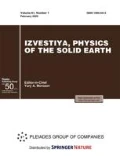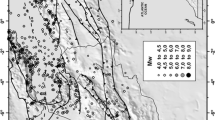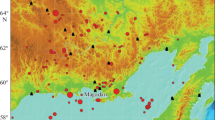Abstract—A joint analysis of seismicity in the Baikal Rift Zone (BRZ) is carried out using modern instrumental data (Baikal Branch of the Federal Research Center “Geophysical Survey of the Russian Academy of Sciences,” 1963–2021) combined together with historical and paleoseismological data on earthquakes. The structure of the seismicity field within BRZ is studied by the new statistical methods. The spatial resolution in the seismically active areas attained 100–120 km. The analysis revealed patches of seismic activity alternating with areas of relative seismic quiescence (seismic gaps). The seismic patches form a hierarchical structure. At the highest level (a spatial scale of 500–1800 km and a lifetime of 300 years and longer), three main patches of seismicity are identified within BRZ, defining the Sayan, Baikal, and Severomuiskii (North Muya) subregions. Smaller patches form a structure with a spatial scale of 100–500 km and a lifetime of 50–200 years. The patches of seismic activity reflect the segmentation of active faults during the seismotectonic evolution of the Earth crust. The estimates of the maximum regional magnitude Mmax from instrumental data for 1963–2021 and from seismogeological data are compared. It is shown that quantile estimates Qq(T) of the maximum earthquakes in the future time interval T are preferable to the Mmax estimates for the seismic risk problems.













Similar content being viewed by others
REFERENCES
Beirlant, J., Kijko, A., Reynkens, T., and Einmahl, J., Estimating the maximum possible earthquake magnitude using extreme value methodology: the Groningen case, Nat. Hazards, 2019, vol. 98, no. 3, pp. 1091–1113.
Chipizubov A.V. and Smekalin O.P., Paleoseismodislocations and related paleoearthquakes along the Major Sayan Fault zone, Geol. Geofiz., 1999, vol. 40, no. 6, pp. 936–947.
Denisenko, I.A. and Lunina, O.V., Seismogenic displacements in the zone of the Zunduk fault according to georadar data (Baikal region), Mater. XXII nauchno-prakt. Shchukinskoi konf. mezhdunar. uchastiem: Struktura, veshchestvennyi sostav, svoistva, sovremennaya geodinamika i seismichnost’ platformennykh territorii i sopredel’nykh regionov (Proc. XXII Sci.-Tech. Shchukin Conf. Int. Participation: Structure, Material Composition, Properties, Recent Geodynamics and Seismicity of Platform Areas and Adjacent Regions), Voronezh, 2020, Voronezh: VGU, 2020, pp. 120–123.
Drescher, A. and De Josselin de Jong, G., Photoelastic verification of a mechanical model for the flow of a granular material, J. Mech. Phys. Solids, 1972, vol. 20, no. 5, pp. 337–351.
Gileva, N.A., Mel’nikova, V.I., Radziminovich, Ya.B., and Tubanov, Ts.A., Strong earthquakes in the Baikal region in 2020–2021, Tezisy dokl. Vseross. soveshch. pamyati professora S.I. Shermana: Razlomoobrazovanie v litosfere i soputstvuyushchie protsessy, tektonofizicheskii analiz (Abstr. All-Russ. Conf. in Memory of Prof. S.I. Sherman: Faulting in the Lithosphere and Related Processes, Tectonophysical Analysis), Irkutsk, 2021, Irkutsk: IGU, 2021, p. 233.
Holschneider, M., Zoller, G., and Hainzl, S., Estimation of the maximum possible magnitude in the framework of the doubly truncated Gutenberg–Richter model, Bull. Seismol. Soc. Am., 2011, vol. 101, no. 4, pp. 1649–1659.
Kagan, Y.Y. and Schoenberg, F., Estimation of the upper cutoff parameter for the tapered Pareto distribution, J. Appl. Probab., 2001, vol. 38(A), pp. 158–175.
Khromovskikh, V.S., Chipizubov, A.V., Smekalin, O.P., Kurushin, R.A., and Delyanskii, E.A., New data on paleoseismic dislocations in the Baikal Rift Zone, in Seysmichnost’ i seismicheskoe raionirovanie Severnoi Yevrazii (Seismicity and Seismic Zoning of Northern Eurasia), Moscow: Minnauki Rossii, 1993.
Kijko, A., Estimation of the maximum earthquake magnitude m max, Pure Appl. Geophys., 2004, vol. 161, no. 8, pp. 1655–1681.
Kijko, A., On Bayesian procedure for maximum earthquake magnitude estimation, Res. Geophys., 2012, vol. 2, no. 1, pp. 46–51.
Kijko, A. and Graham, G., Parametric-historic procedure for probabilistic seismic hazard analysis part I: Estimation of maximum regional magnitude m max, Pure Appl. Geophys., 1998, vol. 152, no. 3, pp. 413–442.
Kijko, A. and Sellevoll, M.A., Estimation of earthquake hazard parameters from incomplete data files. Part I. Utilization of extreme and complete catalogs with different threshold magnitudes, Bull. Seismol. Soc. Am., 1989, vol. 79, no. 3, pp. 645–654.
Kijko, A. and Sellevoll, M.A., Estimation of earthquake hazard parameters from incomplete data files. Part II. Incorporation of magnitude heterogeneity, Bull. Seismol. Soc. Am., 1992, vol. 82, no. 1, pp. 120–134.
Kijko, A. and Singh, M., Statistical tools for maximum possible earthquake magnitude estimation, Acta Geophys., 2011, vol. 59, no. 4, pp. 674–700.
Kondorskaya, N.V. and Shebalin, N.V., Novyi katalog sil’nykh zemletryasenii na territorii SSSR s drevneishikh vremen do 1975 g. (A New Catalog of Strong Earthquakes in the USSR from Ancient Times to 1975), Moscow: Nauka, 1977.
Kullback, S., Information Theory and Statistics, New York: Wiley, 1959.
Lunina, O.V., Gladkov, A.S., Gladkov, A.A., and Denisenko, I.A., Midcrustal paleoseismodislocation in the Baikal ridge: its structure and displacements estimated from ground-penetrating radar data, Geodinam. Tektonofiz., 2018, vol. 9, no. 2, pp. 531–555.
Lyubushin, A.A. and Parvez, I.A., Map of seismic hazard of India using Bayesian approach, Nat. Hazards, 2010, vol. 55, no. 2, pp. 543–556.
Pisarenko, V.F., Statistical evaluation of maximum possible magnitude, Izv. Acad. Sci. USSR, Phys. Solid Earth, 1991, vol. 27, pp. 757–763.
Pisarenko, V.F., Estimating the parameters of truncated Gutenberg–Richter Distribution, Izv., Phys. Solid Earth, 2022, vol. 58, no. 1, pp. 90–99.
Pisarenko, V.F. and Rodkin M.V., Nonparametric methods in studies of the seismic regime, Izv., Phys. Solid Earth, 2008, vol. 44, no. 1, pp. 1–8.
Pisarenko, V.F. and Rodkin, M.V., The instability of the M max parameter and an alternative to its using, Izv., Phys. Solid Earth, 2009, vol. 45, no. 12, pp. 1081–1092.
Pisarenko, V.F. and Rodkin, M.V., Heavy-Tailed Distributions in Disaster Analysis, Dordrecht: Springer. 2010.
Pisarenko, V.F. and Rodkin, M.V., The new quantile approach: application to the seismic risk assessment, in Natural Disasters: Prevention, Risk Factors and Management, Rascovic, B., Mrdja, S., Eds., New York: NOVA, 2013, pp. 141–174.
Pisarenko, V.F. and Rodkin, M.V., The maximum earthquake in future T years: Checking by a real catalog, Chaos, Solitons Fractals, 2015, vol. 74, pp. 89–98.
Pisarenko, V.F. and Rodkin, M.V., Declustering of seismicity flow: statistical analysis, Izv., Phys. Solid Earth, 2019, vol. 55, no. 5, pp. 733–745.
Pisarenko, V.F. and Rodkin, M.V. Statistics and spatial-temporal structure of ground acceleration caused by earthquakes in the North-Western Pacific, Pure Appl. Geophys., 2020, vol. 177, no. 2, pp. 2563–2578.
Pisarenko, V.F. and Rodkin, M.V., Approaches to solving the maximum possible earthquake magnitude (Mmax) problem, Surv. Geophys., 2022. https://doi.org/10.1007/s10712-021-09673-1
Pisarenko, V.F. and Pisarenko, D.V., A modified k-nearest-neighbors method and its application to estimation of seismic intensity, Pure Appl. Geophys., 2021a. https://doi.org/10.1007/s00024-021-02717-y
Pisarenko, V.F., Lyubushin, A.A., Lysenko, V.B., and Go-lubeva, T.V., Statistical estimation of seismic hazard parameters: Maximum possible magnitude and related parameters, Bull. Seismol. Soc. Am., 1996, vol. 86, no. 3, pp. 691–700.
Pisarenko, V., Sornette, A., Sornette, D., and Rodkin, M., New approach to characterization of M max and of the tail of distribution of earthquake magnitudes, Pure Appl. Geophys., 2008, vol. 165, no. 4, pp. 847–888.
Pisarenko, V., Sornette, D., and Rodkin, M., Distribution of maximum earthquake magnitudes in future time intervals: application to the seismicity of Japan (1923–2007), Earth, Planets Space, 2010, vol. 62, no. 7, pp. 567–578.
Pisarenko, V.F., Rodkin, M.V., and Rukavishnikova, T.A., Stable modification of frequency–magnitude relation and prospects for its application in seismic zoning, Izv., Phys. Solid Earth, 2020, vol. 56, no. 1, pp. 53–65.
Pisarenko, V.F., Rodkin, M.V., and Lyubushin, A.A., Maximum earthquakes in future time intervals, Izv., Phys. Solid Earth, 2021b, vol. 57, no. 2, pp. 163–179.
Radziminovich, Ya.B. and Shchetnikov, A.A., The large earthquake of March 8, 1829 in the southwestern flank of the Baikal Rift Zone: updated evidence, Vulkanol. Seismol., 2005, no. 3, pp. 42–50.
Ritz, J.-F., Arzhannikova, A., Vassallo, R., Arzhannikov, S., Larroque, C., Michelot, J.-L., and Massault, M., Characterizing the present-day activity of the Tunka and Sayan faults within their relay zone (western Baikal rift system, Russia), Tectonics, 2018, vol. 37, no. 5, pp. 1376–1392.
Riznichenko, Yu.V., The problem of earthquake magnitude, in Magnituda i energeticheskaya klassifikatsiya zemletryasenii (Magnitude and Energy Classification of Earthquakes), Moscow: 1974, pp. 43–78.
Ruzhich, V.V., Seismotektonicheskaya destruktsiya v zemnoi kore Baykal’skoi riftovoi zony (Seismotectonic Destruction in the Earth’s Crust of the Baikal Rift Zone), Novosibirsk: SO RAN, 1997.
Ruzhich, V.V., Sherman, S.I., and Tarasevich, S.I., New data on thrust faults in the southwestern flank of the Baikal Rift Zone, Dokl. Akad. Nauk SSSR, 1972, vol. 205, no. 4, pp. 920–924.
Ruzhich, V.V., Levina, E.A., Pisarenko, V.F., and Lyu-bushin, A.A., Statistic estimation of the maximum possible earthquake magnitude for the Baikal Rift Zone, Geol. Geofiz., 1998, vol. 39, no. 10, pp. 1443–1455.
Ruzhich, V.V. and Kocharyan, G.G., On the structure and formation of earthquake sources in the faults located in the subsurface and deep levels of the crust. Part I: Subsurface level, Geodinam. Tektonofiz., 2017, vol. 8, no. 4, pp. 1021–1034.
Sadovskii, M.A., Golubeva, T.V., Narkunskaya, G.S., Pisarenko, V.F., Shvarts, G.F., and Shnirman, M.G., Structure of the geophysical medium and seismic process, in Prognoz zemletryasenii (Earthquake Prediction), Dushanbe: DONISH, 1986, pp. 323–336.
Sadovskii, M.A., Bolkhovitinov, L.G., and Pisarenko, V.F., Deformirovanie geofizicheskoi sredy i seismicheskii protsess (Deformation of the Geophysical Medium and the Seismic Process), Moscow: Nauka, 1987.
Salahshoor, H., Lyubushin, A., Shabani, E., and Kazemian, J., Comparison of Bayesian estimates of peak ground acceleration (A max) with PSHA in Iran, J. Seismol., 2018, vol. 22, no. 6, pp. 1515–1527.
San’kov, V.A, Chipizubov, A.V., Lukhnev, A.V., et al., Assessment of strong earthquake hazard in the Main Sayan Fault zone from GPS data and paleoseismological evidence, Russ. Geol. Geophys., 2004, vol. 45, no. 11, pp. 1317–1324.
Shebalin, N.V., Notes on the predominant period, spectrum and slopurce of a strong earthquake. Seismic surveys for construction, in Voprosy inzhenernoi seismologii, vyp. 14 (Issues of Engineering Seismology, vol. 14), Moscow: Nauka, 1971.
Sherman, S.I., Medvedev, M.E., Ruzhich, V.V., et al., Tektonika i vulkanizm yugo-zapadnoi chasti Baykal’skoi riftovoi zony (Tectonics and Volcanism of the Southwestern Part of the Baikal Rift Zone), Moscow: Nauka, 1973.
Solonenko, V.P., Treskov, A.A., and Kurushin, R.A., Zhivaya tektonika, vulkany i seismichnost’ Stanovogo nagor’ya (Live Tectonics, Volcanoes and Seismicity of the Stanovoe Upland), Moscow: Nauka, 1966.
Stock, C. and Smith, E.G.C., Adaptive kernel estimation and continuous probability representation of historical earthquake catalogs, Bull. Seismol. Soc. Am., 2002, vol. 92, no. 3, pp. 904–912.
Tatevossian, R.E., Mokrushina, N.G., Ovsyuchenko, A.N., and Tatevosyan, T.N., Geological and macroseismic effects of the 1957 Muya earthquake and the Cisbaikalian paleoearthquake, Vopr. Inzh. Seismol., 2009, vol. 36, no. 2, pp. 5–30.
Vere-Jones, D., Forecasting earthquakes and earthquake risk, Int. J. Forecast., 1995, vol. 11, no. 4, pp. 503–538.
Vermeulen, P. and Kijko, A., More statistical tools for maximum possible earthquake magnitude estimation, Acta Geophys., 2017, vol. 65, no. 3, pp. 1–9.
Zamarayev, S.M. and Ruzhich, V.V., On relationships between the Baikal rift and ancient structures, Tectonophysics, 1978, vol. 45, no. 1, pp. 41–47.
Zentner, I., Ameri, G., and Viallet, E., Bayesian estimation of the maximum magnitude m max based on the extreme value distribution for probabilistic seismic hazard analysis, Pure Appl. Geophys., 2020, vol. 177, no. 12, pp. 5643–5660.
Zoller, G. and Holschneider, M., The maximum possible and the maximum expected earthquake magnitude for production-induced earthquakes at the gas field in Groningen, The Netherlands, Bull. Seismol. Soc. Am., 2016, vol. 106, no. 6, pp. 2917–2921.
Zoller, G., Holschneider, M., and Hainzl, S., The maximum earthquake magnitude in a time horizon: theory and case studies, Bull. Seismol. Soc. Am., 2013, vol. 103, no. 2A, pp. 860–875.
Funding
The work was partly supported by the Russian Foundation for Basic Research under project no. 20-05-00433 (V.F. Pisarenko and A.A. Skorkina) and under the basic budgetary funded project no. FWEF-2021-0009 “Recent geodynamics, mechanisms of lithosphere destruction and hazardous geological processes in Central Asia” (V.V. Ruzhich and E.A. Levina).
Author information
Authors and Affiliations
Corresponding author
Ethics declarations
The authors declare that they have no conflicts of interest.
Additional information
Translated by M. Nazarenko
Rights and permissions
About this article
Cite this article
Pisarenko, V.F., Ruzhich, V.V., Skorkina, A.A. et al. The Structure of Seismicity Field in the Baikal Rift Zone. Izv., Phys. Solid Earth 58, 329–345 (2022). https://doi.org/10.1134/S1069351322030053
Received:
Revised:
Accepted:
Published:
Issue Date:
DOI: https://doi.org/10.1134/S1069351322030053




